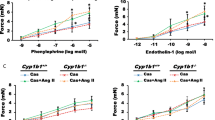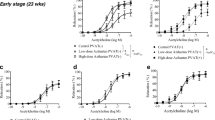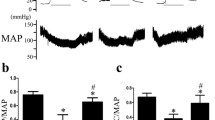Abstract
Endothelial dysfunction and increased blood pressure following insulin resistance play an important role in the development of secondary cardiovascular complications. The presence of testosterone is essential for the development of endothelial dysfunction and increased blood pressure. Testosterone regulates the synthesis of vasoconstrictor eicosanoids such as 20-hydroxyeicosatetranoic acid (20-HETE). In a series of studies, we examined: (1) the role of the androgen receptor in elevating blood pressure and (2) the effects of Cyp4A-catalyzed 20-HETE synthesis on vascular reactivity and blood pressure in fructose-fed rats. In the first study, intact and castrated male rats were made insulin resistant by feeding fructose for 9 weeks following which their superior mesenteric arteries (SMA) were isolated and examined for changes in endothelium-dependent relaxation in the presence and absence of 1-aminobenzotriazole (ABT) and N-methylsulfonyl-12,12-dibromododec-11-enamide (DDMS), which are inhibitors of 20-HETE synthesis. In another study, male rats were treated with either ABT or the androgen receptor blocker, flutamide, following which changes in insulin sensitivity, blood pressure, and vascular Cyp4A expression were measured. In the final study, HET0016, which is a more selective inhibitor of 20-HETE synthesis, was used to confirm our earlier findings. Treatment with HET0016 or ABT prevented or ameliorated the increase in blood pressure. Gonadectomy or flutamide prevented the increase in both the Cyp4A and blood pressure. Furthermore, both ABT and DDMS improved relaxation only in the intact fructose-fed rats. Taken together our results suggest that in the presence of testosterone, the Cyp4A/20-HETE system plays a key role in elevating the blood pressure secondary to insulin resistance.







Similar content being viewed by others
References
Vasudevan H, Nagareddy PR, McNeill JH (2006) Gonadectomy prevents endothelial dysfunction in fructose-fed male rats, a factor contributing to the development of hypertension. Am J Physiol Heart Circ Physiol 291:H3058–H3064
Verma S, Bhanot S, Yao L, McNeill JH (1996) Defective endothelium-dependent relaxation in fructose-hypertensive rats. Am J Hypertens 9:370–376
Katakam PV, Ujhelyi MR, Miller AW (1999) EDHF-mediated relaxation is impaired in fructose-fed rats. J Cardiovasc Pharmacol 34:461–467
Song D, Arikawa E, Galipeau D, Battell M, McNeill JH (2004) Androgens are necessary for the development of fructose-induced hypertension. Hypertension 43:667–672
Vasudevan H, Xiang H, McNeill JH (2005) Differential regulation of insulin resistance and hypertension by sex hormones in fructose-fed male rats. Am J Physiol Heart Circ Physiol 289:H1335–H1342
Reckelhoff JF, Zhang H, Srivastava K, Granger JP (1999) Gender differences in hypertension in spontaneously hypertensive rats: role of androgens and androgen receptor. Hypertension 34:920–923
Reckelhoff JF, Zhang H, Srivastava K (2000) Gender differences in development of hypertension in spontaneously hypertensive rats: role of the renin-angiotensin system. Hypertension 35:480–483
Yanes LL, Sartori-Valinotti JC, Iliescu R, Romero DG, Racusen LC, Zhang H, Reckelhoff JF (2009) Testosterone-dependent hypertension and upregulation of intrarenal angiotensinogen in Dahl salt-sensitive rats. Am J Physiol Renal Physiol 296:F771–F779
Bogatcheva NV, Sergeeva MG, Dudek SM, Verin AD (2005) Arachidonic acid cascade in endothelial pathobiology. Microvasc Res 69:107–127
Vanhoutte PM, Feletou M, Taddei S (2005) Endothelium-dependent contractions in hypertension. Br J Pharmacol 144:449–458
Galipeau D, Arikawa E, Sekirov I, McNeill JH (2001) Chronic thromboxane synthase inhibition prevents fructose-induced hypertension. Hypertension 38:872–876
Jiang J, Tran L, Vasudevan H, Xia Z, Yuen VG, McNeill JH (2007) Endothelin-1 blockade prevents COX2 induction and TXA2 production in the fructose hypertensive rat. Can J Physiol Pharmacol 85:422–429
Vasudevan H, Lau SM, Jiang J, Galipeau D, McNeill JH (2010) Effects of insulin resistance and testosterone on the participation of cyclooxygenase isoforms in vascular reactivity. J Exp Pharmacol 2:169–179
Vasudevan H (2009) Testosterone-dependent vascular arachidonic acid metabolism in the regulation of insulin resistance and blood pressure. Faculty of Pharmaceutical Sciences, University of British Columbia, Vancouver, pp 1–151
Roman RJ (2002) P-450 metabolites of arachidonic acid in the control of cardiovascular function. Physiol Rev 82:131–185
Holla VR, Adas F, Imig JD, Zhao X, Price E Jr, Olsen N, Kovacs WJ, Magnuson MA, Keeney DS, Breyer MD, Falck JR, Waterman MR, Capdevila JH (2001) Alterations in the regulation of androgen-sensitive Cyp 4a monooxygenases cause hypertension. Proc Natl Acad Sci USA 98:5211–5216
Nakagawa K, Marji JS, Schwartzman ML, Waterman MR, Capdevila JH (2003) Androgen-mediated induction of the kidney arachidonate hydroxylases is associated with the development of hypertension. Am J Physiol Regul Integr Comp Physiol 284:R1055–R1062
Singh H, Cheng J, Deng H, Kemp R, Ishizuka T, Nasjletti A, Schwartzman ML (2007) Vascular cytochrome P450 4A expression and 20-hydroxyeicosatetraenoic acid synthesis contribute to endothelial dysfunction in androgen-induced hypertension. Hypertension 50:123–129
Miyata N, Roman RJ (2005) Role of 20-hydroxyeicosatetraenoic acid (20-HETE) in vascular system. J Smooth Muscle Res 41:175–193
Cheng J, Ou JS, Singh H, Falck JR, Narsimhaswamy D, Pritchard KA Jr, Schwartzman ML (2008) 20-Hydroxyeicosatetraenoic acid causes endothelial dysfunction via eNOS uncoupling. Am J Physiol Heart Circ Physiol 294:H1018–H1026
Cheng J, Ou JS, Singh H, Falck JR, Narsimhaswamy D, Pritchard KA Jr, Schwartzman ML (2008) 20-Hydroxyeicosatetraenoic acid causes endothelial dysfunction via eNOS uncoupling. American journal of physiology. Heart and circulatory physiology 294:H1018–H1026
Cheng J, Wu CC, Gotlinger KH, Zhang F, Falck JR, Narsimhaswamy D, Schwartzman ML (2010) 20-hydroxy-5,8,11,14-eicosatetraenoic acid mediates endothelial dysfunction via IkappaB kinase-dependent endothelial nitric-oxide synthase uncoupling. J Pharmacol Exp Ther 332:57–65
Berezan DJ, Dunn KM, Falck JR, Davidge ST (2008) Aging increases cytochrome P450 4A modulation of alpha1-adrenergic vasoconstriction in mesenteric arteries. J Cardiovasc Pharmacol 51:327–330
Croft KD, McGiff JC, Sanchez-Mendoza A, Carroll MA (2000) Angiotensin II releases 20-HETE from rat renal microvessels. Am J Physiol Renal Physiol 279:F544–F551
Barnett CR, Rudd S, Flatt PR, Ioannides C (1993) Sex differences in the diabetes-induced modulation of rat hepatic cytochrome P450 proteins. Biochem Pharmacol 45:313–319
Benter IF, Yousif MH, Canatan H, Akhtar S (2005) Inhibition of Ca2+/calmodulin-dependent protein kinase II, RAS-GTPase and 20-hydroxyeicosatetraenoic acid attenuates the development of diabetes-induced vascular dysfunction in the rat carotid artery. Pharmacol Res 52:252–257
Chen YJ, Li J, Quilley J (2008) Deficient renal 20-HETE release in the diabetic rat is not the result of oxidative stress. Am J Physiol Heart Circ Physiol 294:H2305–H2312
Laffer CL, Laniado-Schwartzman M, Nasjletti A, Elijovich F (2004) 20-HETE and circulating insulin in essential hypertension with obesity. Hypertension 43:388–392
Wang MH, Smith A, Zhou Y, Chang HH, Lin S, Zhao X, Imig JD, Dorrance AM (2003) Downregulation of renal CYP-derived eicosanoid synthesis in rats with diet-induced hypertension. Hypertension 42:594–599
Tsai IJ, Croft KD, Mori TA, Falck JR, Beilin LJ, Puddey IB, Barden AE (2009) 20-HETE and F2-isoprostanes in the metabolic syndrome: the effect of weight reduction. Free Radic Biol Med 46:263–270
Ward NC, Hodgson JM, Puddey IB, Beilin LJ, Croft KD (2006) 20-Hydroxyeicosatetraenoic acid is not associated with circulating insulin in lean to overweight humans. Diabetes Res Clin Pract 74:197–200
Dunn KM, Renic M, Flasch AK, Harder DR, Falck J, Roman RJ (2008) Elevated production of 20-HETE in the cerebral vasculature contributes to severity of ischemic stroke and oxidative stress in spontaneously hypertensive rats. Am J Physiol Heart Circ Physiol 295:H2455–H2465
Hwang IS, Ho H, Hoffman BB, Reaven GM (1987) Fructose-induced insulin resistance and hypertension in rats. Hypertension 10:512–516
Llinas MT, Alexander BT, Capparelli MF, Carroll MA, Granger JP (2004) Cytochrome P-450 inhibition attenuates hypertension induced by reductions in uterine perfusion pressure in pregnant rats. Hypertension 43:623–628
Miyata N, Taniguchi K, Seki T, Ishimoto T, Sato-Watanabe M, Yasuda Y, Doi M, Kametani S, Tomishima Y, Ueki T, Sato M, Kameo K (2001) HET0016, a potent and selective inhibitor of 20-HETE synthesizing enzyme. Br J Pharmacol 133:325–329
Sato M, Ishii T, Kobayashi-Matsunaga Y, Amada H, Taniguchi K, Miyata N, Kameo K (2001) Discovery of a N′-hydroxyphenylformamidine derivative HET0016 as a potent and selective 20-HETE synthase inhibitor. Bioorg Med Chem Lett 11:2993–2995
Seki T, Wang MH, Miyata N, Laniado-Schwartzman M (2005) Cytochrome P450 4A isoform inhibitory profile of N-hydroxy-N′-(4-butyl-2-methylphenyl)-formamidine (HET0016), a selective inhibitor of 20-HETE synthesis. Biol Pharm Bull 28:1651–1654
Hoagland KM, Flasch AK, Roman RJ (2003) Inhibitors of 20-HETE formation promote salt-sensitive hypertension in rats. Hypertension 42:669–673
Blanton A, Nsaif R, Hercule H, Oyekan A (2006) Nitric oxide/cytochrome P450 interactions in cyclosporin A-induced effects in the rat. J Hypertens 24:1865–1872
Vasudevan H (2005) Potential role of sex hormones in altered vascular relaxation following insulin resistance. Faculty of Pharmaceutical Sciences, University of British Columbia, Vancouver, pp 1–99
Matsuda M, DeFronzo RA (1999) Insulin sensitivity indices obtained from oral glucose tolerance testing: comparison with the euglycemic insulin clamp. Diabetes Care 22:1462–1470
Ito O, Alonso-Galicia M, Hopp KA, Roman RJ (1998) Localization of cytochrome P-450 4A isoforms along the rat nephron. Am J Physiol 274:F395–F404
Katakam PV, Ujhelyi MR, Hoenig ME, Miller AW (1998) Endothelial dysfunction precedes hypertension in diet-induced insulin resistance. Am J Physiol 275:R788–R792
Linder CD, Renaud NA, Hutzler JM (2009) Is 1-aminobenzotriazole an appropriate in vitro tool as a nonspecific cytochrome P450 inactivator? Drug Metab Dispos 37:10–13
Hong HJ, Liu JC, Chan P, Juan SH, Loh SH, Lin JG, Cheng TH (2004) 17b-estradiol downregulates angiotensin-II-induced endothelin-1 gene expression in rat aortic smooth muscle cells. J Biomed Sci 11:27–36
Nagareddy PR (2009) Mechanisms of vascular dysfunction in diabetes and hypertension. Faculty of Pharmaceutical Sciences, University of British Columbia, Vancouver, p 267
Acknowledgments
This project was funded by grants-in aid from The Heart and Stroke Foundation of BC and Yukon (HSFBCY) and Canadian Institutes of Health Research (CIHR-Priority announcement grant from the Institute of Gender and Health) to Dr. McNeill. Harish Vasudevan was funded by a Doctoral Research Award from the Heart and Stroke Foundation of Canada and a Senior Graduate Studentship from the Michael Smith Foundation for Health Research British Columbia, Canada.
Author information
Authors and Affiliations
Corresponding author
Rights and permissions
About this article
Cite this article
Vasudevan, H., Yuen, V.G. & McNeill, J.H. Testosterone-dependent increase in blood pressure is mediated by elevated Cyp4A expression in fructose-fed rats. Mol Cell Biochem 359, 409–418 (2012). https://doi.org/10.1007/s11010-011-1035-7
Received:
Accepted:
Published:
Issue Date:
DOI: https://doi.org/10.1007/s11010-011-1035-7




